What is the best color correction for the screen?
Many people stared at the computer screen all day - if you were reading this article, you might be in that situation, but very few people took the time to calibrate the computer screen. Proper calibration will make colors more realistic and the screen will produce the best results when viewing, editing videos and photos. Moreover, it also helps the eyes less tired.
- Which screen parameters are completely meaningless?
The instructions for adjusting the screen below will help the colors to always be displayed correctly. While it is not possible to guarantee that it will yield the best results, it will also help you know what settings your monitor manufacturer recommends.
A few notes before calibrating the computer screen
- Turn on the screen for at least half an hour before adjusting so that it is heated to normal operating temperatures and conditions.
- Set the screen resolution to native, default resolution.
- Make sure you are calibrating the monitor in a room with moderate ambient light. The room does not need to be dark, but it should not be too bright or too colorful.
- Familiarize yourself with the controls displayed on the screen. They can be placed on the screen itself, on the keyboard or in the Control Panel of the operating system.
Color temperature
Most of the LCD monitors at factory have a default color temperature of 9300K, with this temperature, the display color will be blue. To adjust the color to ' warm ', you need to bring this temperature to 6500K (equivalent to the level of natural light outdoors). You can find the color temperature option through the screen buttons, usually in the color image settings section . Depending on the particular monitor type, the 6500K level may be set by the manufacturer to 6500K, D65 or sRGB.

Brightness and contrast
This is an important factor for image quality because if the screen is too dark, all colors darker than a certain threshold will be displayed in black, and if the screen is too bright, the colors are brighter than the threshold that will appear white. This means that you will not be able to see details in the dark areas of an image like the shadow of an object and the same for a bright area.
So how to correct it? You can rely on a chart that includes 21 color shades starting from complete black and lightening to white as shown below.
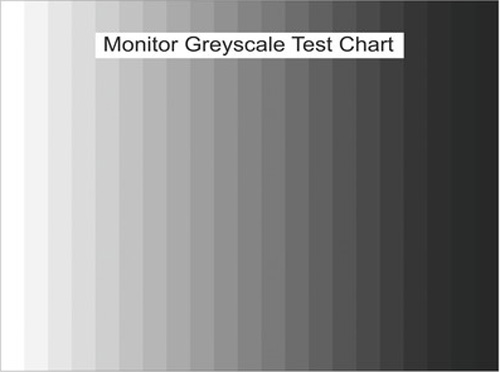
To ensure accurate work should be carried out in a soft light environment, without direct light on the screen or in too dark position. Before proceeding, make sure that the screen is set to the default resolution, you can through the graphics card driver to bring the screen to this resolution. For the Nvidia Control Panel, in the Display -> Change resolution section, find the resolution with the word ' native ' next to the default resolution.
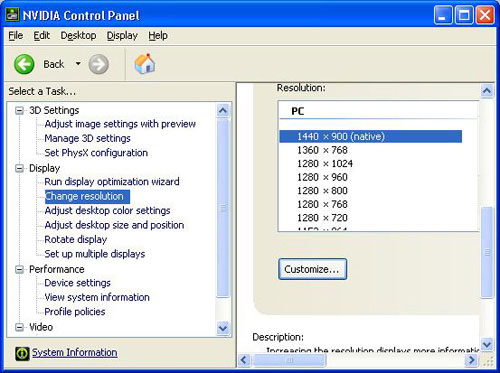
For Catalyst Control Center for ATI graphics cards, there will be no sign of what is the standard resolution of the monitor, so you have to look in the manual that comes with the screen (sometimes it is recorded) right on the screen when you choose wrong.
Another way to know the screen's default resolution is if you use Windows 7, right-click the desktop and select Screen Resolution . And you can choose which resolution has the word Recommended at the side.
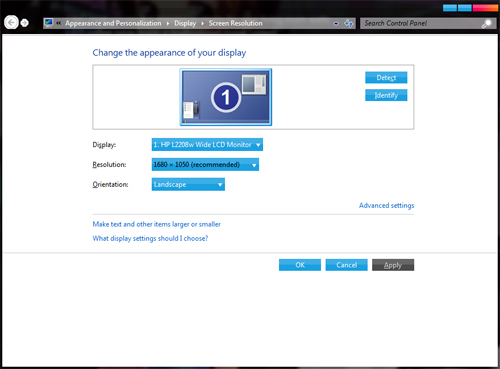
Adjust screen brightness and contrast so that 21 shades of the above chart can be clearly distinguished. First start by setting up 100% contrast for CRT screens or 40% for LCD screens, then proceed to adjust the brightness to the minimum required by the chart. Whether the adjustment is easy or not depends on the quality of the screen.
Edit Gamma
The Gamma index affects the middle tone colors, for example, for gray if the gamma is too low, the display color will become close to white and vice versa too high to distinguish it from black. . To adjust the gamma index accordingly, we rely on a picture consisting of a black square as a background and a circle in the middle.

The goal of adjusting Gamma is to make the left half of the circle almost disappear (overlapping black with the background) while the right half is still visible.
In addition to adjusting the general gamma for all three colors (red, green, blue), you can adjust gamma for each individual color via the screen or driver function. Instead of a black and white chart is a chart of 3 distinct colors.
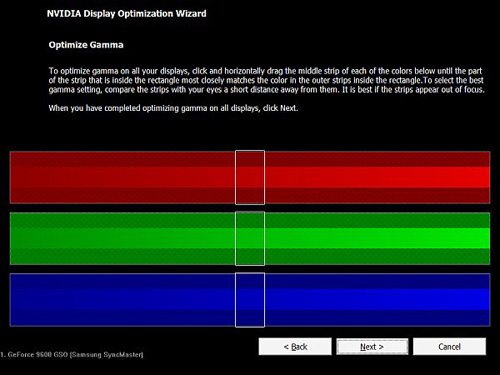
This process is done by adjusting the color band in the middle so that the color in the rectangular frame is close to the two remaining color bands. It sounds simple, but it is not easy to do it because focusing on the screen will cause eye strain, leading to inaccurate observation, especially dark blue, so it is easy to correct so it is best You should only adjust gamma for one color if the color on the screen is excessive.
Edit the screen with Windows built-in tools
Step 1: Open the screen calibration tool
On Windows 10, this calibration tool is set in Settings, you can enter " Calibrate display color " into the search bar or follow these steps to open the tool:
- Open Settings > select System > Display > scroll down to find Advanced Display Settings .
- Scroll down, under Color Settings you will see the Color calibration.
- On different versions of Windows 10 this option can be located in different locations, if you cannot find Advanced Display Settings, then try Display to a wireless display > select the Color Managerment tab and click the Color Management button . > select the Advanced tab in the window that opens> select Calibrate display .
On Windows 7/8 / 8.1 and earlier versions, you can find the Color Calibration tool in the Display section of the Control Panel (listed in Apperance and Personalization).
Step 2: Follow the on-screen instructions to select Gamma settings, brightness, contrast and color balance.
On the first screen, click on the words " How do I calibrate my display? ", Windows will show instructions for you to edit your screen. Each tutorial will come with sample images, let you know what is good / not good Gamma level, good / dark / too bright brightness, good contrast / not good, . you just need to adjust the slider on the screen to reach the desired setting, then click Next to go to the next installation.
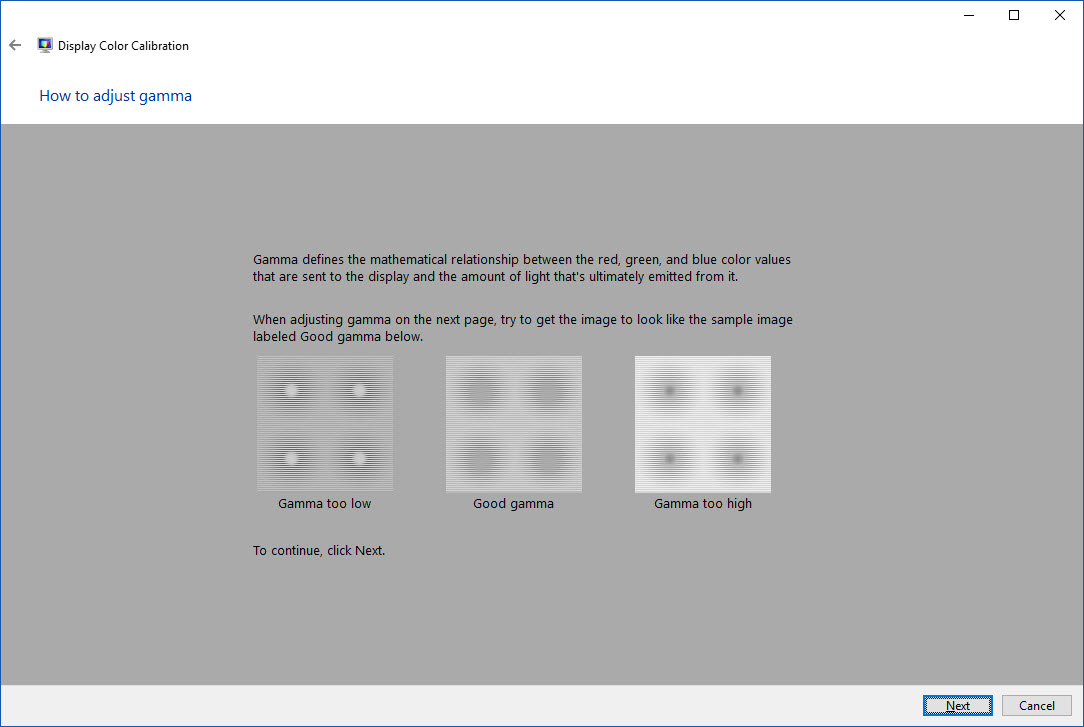
The wizard for adjusting screen colors on Windows 10
Step 3: Complete editing the screen.
When the color correction wizard is complete, you can choose to keep the current calibration or go back to the previous calibration if you're not satisfied.
New edits will be saved in the .ics file, or color correction file and will be displayed in the International Color Consortium (ICC) new Profile in the Color Management settings. The easiest way to open this profile is to enter "color management" into the search box and select the first result. When the window opens, select the screen from the Device list and see the available ICC Profile.
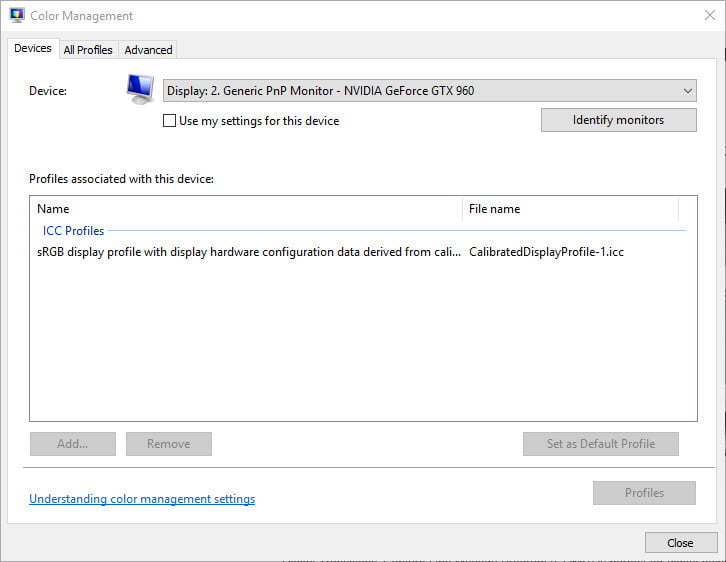
View existing ICC Profile
Calibrate the screen with the built-in macOS tool
On Mac computers, Display Calibrator Assistant is located in System Preferences , under the Displays tab. If you're having trouble finding this tool, enter the calibrate in Spotlight to find it. The result will return the option to open the tool in the System Preferences control panel.
Open the tool, you will see a step-by-step calibration guide, follow this guide to select brightness, contrast, and gamma, and then click Next until the adjustments are completed.
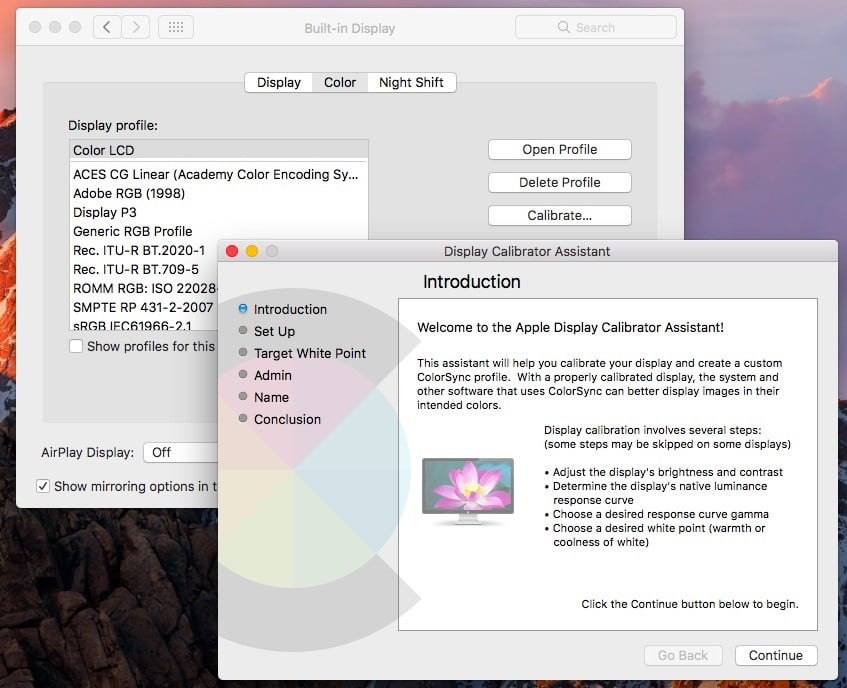
Edit screen with online tool
There are a number of online screen editing tools that help you adjust the screen settings. They can provide more accurate, customizable calibration than the built-in tools. Here are 3 most prominent names:
- Photo Friday: This tool helps you to adjust the brightness and contrast of the screen. Just adjust the screen settings until the transition from black to white tones can be clearly distinguished on the screen.
- Online Monitor Test: This is one of the highly calibrated screen calibration tools. It offers a series of interactive tests that help you adjust the screen colors and see if the screen is displayed smoothly. It also has a tool to find broken pixels and a backlight lamp is dead.
- The Lagom LCD Monitor Test Pages: The tool allows to adjust various things such as contrast, response time, download images to the computer as a 120kb Zip file to be able to check any screen you are planning buying.
Calibrate the screen with colorimetric hardware
In addition to the built-in tools of the operating system or online screen adjustment tool, you can also use third-party screen calibration devices. If you are looking for such a device you can consider Spyder5Express ($ 130), Spyder5Pro ($ 170), or Spyder5Elite ($ 280). These 3 devices have 7-color, full-spectrum sensors that accurately describe a wide range of wide color gamut and regular screen, more expensive devices will have more advanced features and tuners .
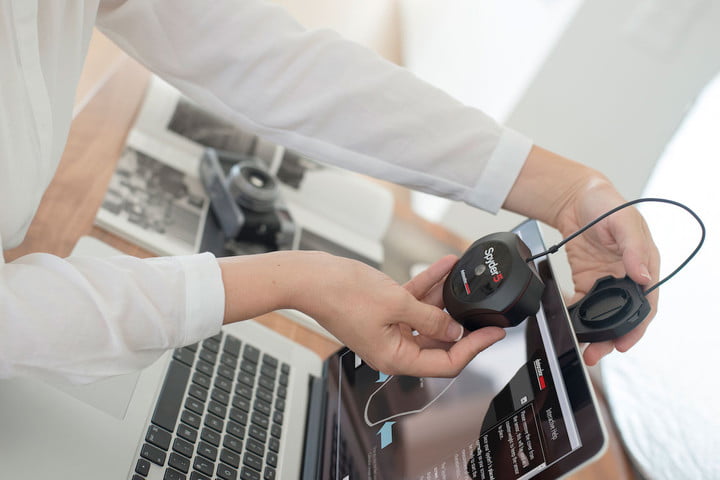
Screen color correction with Spyder5 device
After purchasing the device, you just need to attach it to the screen, connect the device to the USB port and run the calibration software available on the device to have the calibration instructions appear.
See more:
- What does the Refresh Rate parameter on the computer screen, TV mean?
- What parameters Response Time on the computer screen, TV mean?
- 14 secrets of a laptop buyer
- Instructions for checking the temperature of CPU, VGA, hard drive of computer, laptop
You should read it
- Adjust screen brightness of Windows 7 on PC, laptop
- What is Nit screen brightness?
- Instructions to adjust the screen brightness of Android phones
- Top software to adjust the best computer screen brightness
- How to Adjust, Tilt, and Turn Your Windows Screen
- How to adjust the brightness of the Laptop computer screen
- How to turn on 144Hz (or higher) on dedicated gaming screens
- How to adjust the colors displayed on Galaxy S9
May be interested
- Top CPU gaming worth buying 2018
 if you want to upgrade your gaming computer, which cpu will you choose? here are the best cpu models available today, users can consult to get the best option for giving their gaming pc.
if you want to upgrade your gaming computer, which cpu will you choose? here are the best cpu models available today, users can consult to get the best option for giving their gaming pc. - Top best headphones for gamers 2018
 when playing pc games and want to communicate effectively in multiplayer online games, headphones are indispensable devices. here are the best products on the market today.
when playing pc games and want to communicate effectively in multiplayer online games, headphones are indispensable devices. here are the best products on the market today. - Top 10 best Wi-Fi USB 2018
 good internet connection is an essential part of keeping in touch with the world. if your computer doesn't have a built-in wi-fi connection, there are plenty of usb wi-fi on the market to give you the choice of serving many purposes such as watching netflix, browsing the web or playing games.
good internet connection is an essential part of keeping in touch with the world. if your computer doesn't have a built-in wi-fi connection, there are plenty of usb wi-fi on the market to give you the choice of serving many purposes such as watching netflix, browsing the web or playing games. - The best laptop keyboards 2018
 when choosing to buy a laptop, in addition to considering the design and configuration of the user device should also consider the device keyboard.
when choosing to buy a laptop, in addition to considering the design and configuration of the user device should also consider the device keyboard. - Reputable computer repair addresses in Hanoi
 with the top address of laptop repair in hanoi, you can rest assured to send your beloved laptop, because these are all facilities that most users appreciate both in service quality and price. both.
with the top address of laptop repair in hanoi, you can rest assured to send your beloved laptop, because these are all facilities that most users appreciate both in service quality and price. both. - Top 6 best noise canceling headphones 2018
 anti-noise headphones have a noise-canceling effect so you can enjoy the music more amazingly but choosing headphones for good is not an easy task.
anti-noise headphones have a noise-canceling effect so you can enjoy the music more amazingly but choosing headphones for good is not an easy task.






 How to adjust the colors displayed on Galaxy S9
How to adjust the colors displayed on Galaxy S9 Top 3 video color correction applications for iPhone
Top 3 video color correction applications for iPhone Top 10 formulas for VSCO image correction
Top 10 formulas for VSCO image correction 100+ most beautiful VSCO color correction formulas on Pinterest
100+ most beautiful VSCO color correction formulas on Pinterest How to adjust the color of the computer screen helps with eye strain
How to adjust the color of the computer screen helps with eye strain